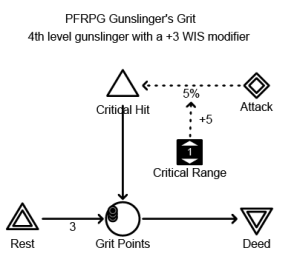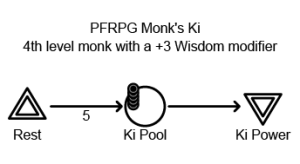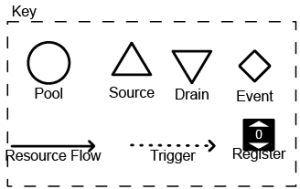During a discussion of Pathfinder RPG content design, a fellow brought up the idea of combining all class resource pools (ki, grit, panache, arcane pool points, etc) into a single pool shared by all classes. I replied that this would homogenize classes since a resource pool’s design can influence how a class feels with respect to utilizing their abilities. I cited the difference between the gunslinger class’s grit and the monk class’s ki as an example.
Jacob “Jiggy” Kellogg disagreed, begging the question why grit feels different from ki when the only differences between the pools are what abilities the player can spend the resource points on and grit’s recharge mechanic. Short answer: grit’s recharge mechanic changes everything, influencing how the class plays out and making it distinct from other resource pools in the game.
However, I believe Jacob raises a good question that deserves much more illustration than a one-line response. So let’s take a look at grit and ki with the help of Machinations introduced by Joris Dormans.
Mechanical Structure of Ki & Grit
Ki is a resource pool with a capacity equal to half the monk’s level plus his Wisdom modifier. The ki pool replenishes to capacity each day.
Grit is a resource pool with a capacity equal to the gunslinger’s Wisdom modifier. The pool replenishes each day. However, the gunslinger gains 1 grit point every time he scores a critical hit or kills a sufficiently threatening foe. This and the lower capacity serves as the crucial difference between the two pools, completely changing how a player utilizes them.
In terms coined by Joris Dormans, ki is a static engine whereas grit is a dynamic engine. Aside from resting, a monk has no influence over how he gains ki. On the other hand, a gunslinger has a 5% percent chance of gaining a grit point on each attack, assuming she confirms each critical hit. The more she attacks, the more likely she’ll gain grit points. Increasing the critical range of her weapon will also increase her grit production rate. You can see this in the machination diagrams below.
Gameplay Consequences
So why is this such a big deal?
1. Grit encourages a different type of play pattern than ki. Grit has a feedback loop that rewards a player for fighting. In addition, a player can increase the production rate by investing into feats and weapons that increase the critical range and the number of attacks they can do per round. This also provides a way of gating usage of special abilities without resorting to a usage-per-day paradigm.
2. Management and usage of abilities differ with grit and ki. The grit mechanic encourages the gunslinger to use her abilities regularly since any gained grit point is lost if she’s already at her capacity. The grit pool constantly fluctuates whereas ki remains static over the course of the day. As a result, the gunslinger feels encouraged to use her abilities more often whereas the monk feels encouraged to ration ki points over the course of the day.
3. Both resource pools scale differently with level. A monk’s ki pool increases in capacity as he levels up. A gunslinger’s grit pool never increases in capacity unless she invests in Wisdom-boosting gear. However, a gunslinger gains more iterative attacks as she levels and gains access to feats that increase her critical range. So while the capacity doesn’t change, grit’s production rate greatly increases, ramping up the fluctuating behavior of the resource pool.
Conclusion
One thing is clear. Ki and grit are not the same. Structure-wise, grit is a more elaborate type of resource engine than ki. Each pool encourages different patterns of gameplay and management. Each flows and scales with level differently. Grit also provides more ways for a player to invest towards their resource pool through character buildings.
While not without flaws, grit serves a great example of how a game economy makes for a powerful game design tool in creating emergent gameplay that conveys a “feel” to the player.
Is grit better than ki? No, that depends on design goals and the abilities of the class. If a class has the ability to regain powerful spells by spending points, you probably don’t want a recharge mechanic like grit. But grit certainly has more depth and more ways for a player to interact with it.
In future articles, I will look at other resource systems, including an unusual resource pool serving as the foundation for a homebrew Pathfinder class in the works.



Pingback: Rhetoric Studios | Tension Mechanic